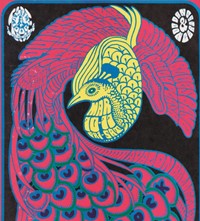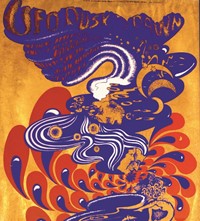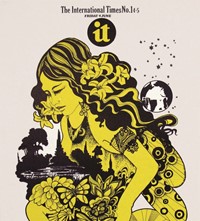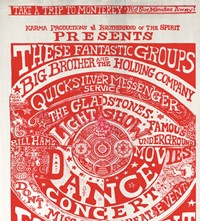Alongside a preview of Rock Graphic Originals: Revolutions in Sonic Art from Plate to Print ‘55–’88, British designer and rock art collector Peter Golding discusses the power of poster art
- TextDaisy Woodward
It’s impossible to think of mid-60s psychedelic culture without picturing the eye-popping posters that provided a swirling visual counterpart to the pounding acid rock that shook America’s West Coast, and the more dreamy pop-psychedelia that cast its hypnotic spell over Britain’s underground scene. On both sides of the pond, unaware of each other’s work, a number of American and British artists began creating posters to promote the many dance events bringing together like-minded, liberal thinkers hellbent on freeing their bodies and minds through music, drugs and sexual liberation.
In San Francisco artists such as Rick Griffin, Victor Moscoso and Mouse Kelley drew on sources as varied as old-time Western advertising, photographs of Golden Era Hollywood stars, cartoon characters and Art Nouveau and Art Deco posters to conjure attention-commanding prints in bold colours. While in London artists like Michael English and Nigel Weymouth (aka Hapshash and the Coloured Coat) were drawing on the sinuous lines of Aubrey Beardsley and Alfons Mucha to create a radical new poster style – “packed with secret signs, prehistoric forms an flying saucers” – to promote concerts at the iconic UFO Club.
Now, a new book from Thames & Hudson, titled Rock Graphic Originals: Revolutions in Sonic Art from Plate to Print ‘55–’88, traces the colourful history of psychedelic poster art from its beat origins to its stadium rock zenith, centred around the former archive of British designer and rock art collector Peter Golding, and accompanied by text from author Barry Miles, founder of the legendary underground newspaper International Times. Here, Golding discusses the power of the poster and the joyful spirit of the era these artworks encapsulate.
“The thing that started it all was a poster that I found at a Hyde Park indie gathering in July 1967 – the Pot Rally. I picked it up off the floor. It says: ‘Summer’s here and the time is right for fighting in the street’. It’s hand stencilled and if you look closely, you can see they’ve missed out a ‘t’ in ‘street’. That was the first one in my collection. After that I became friends with the Hapshash guys and Mike McInnerny in London – I was very much into the UFO Club at the time. Later I discovered the work of Rick Griffin, the Jimi Hendrix of American rock and roll graphics, and when he passed away in the 90s, I bought his archive. Then I met Stanley Mouse and the other American artists and began buying from them – and my collection grew and grew.
“There’s a huge difference between American and British poster art. In Britain it only really spanned the 60s and 70s whereas it went on into the 80s and early 90s in America because of the longevity of bands like The Grateful Dead; it was a much bigger affair. Here it was more underground, and the British posters feel driven more by acid and dreams. There’s an aggression in the American posters: they’re slightly harder, not so dreamlike or spiritual. They had a lot to be angry about: racial segregation, the Vietnam War and so on. Here it was relatively tame – legalise pot!
“For me, it was less about the posters, even though they’re beautiful artworks, and more about the excitement of the time they were made. What I loved was the energy, the spirit that they capture, and which pulsed through the music – The Stones, Clapton, Hendrix, Sgt Pepper’s Lonely Hearts Club Band. There was a fire in the belly of the movement and its people. Now feels like a good time for the book to come out, with all the political unrest, and for the young to see the power of posters to communicate a message.”
Rock Graphic Originals: Revolutions in Sonic Art from Plate to Print ‘55–’88 is out now, published by Thames & Hudson.















